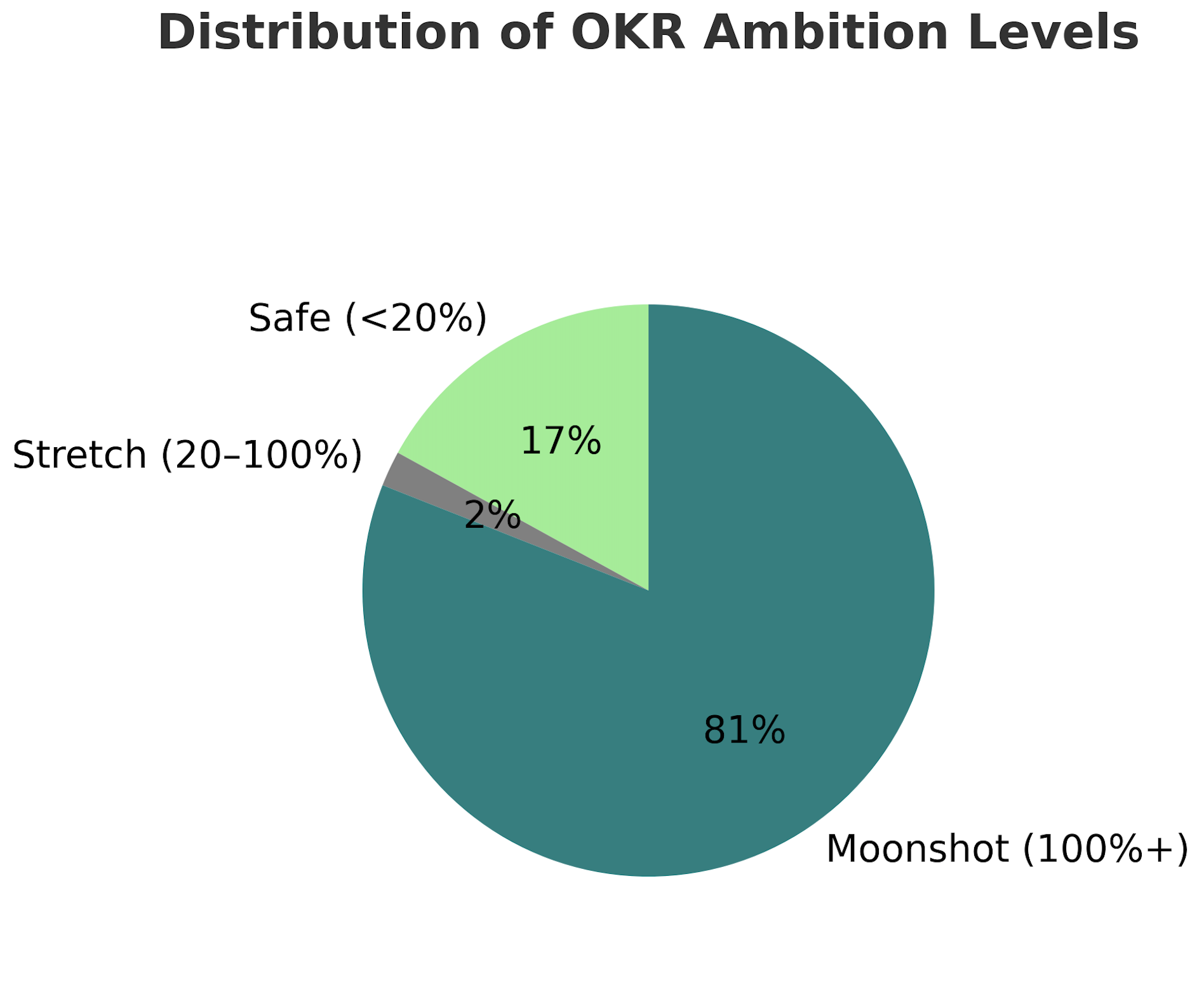Every founder wants their team to aim high.
But there’s a difference between ambition and illusion.
After reviewing 3,500+ Key Results from 650 startups in OKRs Tool, the pattern was clear: most teams aren’t playing it safe - they’re skipping straight to extremes.
- 17% were “safe” goals, aiming for less than 20% improvement.
- 1–2% sat in the healthy 20–100% stretch goal zone - the middle ground where OKRs thrive.
- 82% were moonshots, chasing 2x, 5x, or even 10x growth in a single cycle.
The real problem isn’t lack of ambition. It’s polarization - startups swinging between tiny wins and impossible leaps, while ignoring the middle ground where real progress happens.
So what does that polarization actually look like in the data? Let’s break it down.
The Data: Where Startups Actually Set Their Targets
The numbers tell a clear story.
Out of nearly 3,600 Key Results, most startups skipped the healthy middle zone entirely.
Only a handful of teams set stretch goals in the 20–100% range - the zone where OKRs are ambitious but achievable.

Instead, founders gravitated toward two extremes:
- Modest, low-risk goals that don’t inspire progress.
- Massive moonshots that look bold but break execution.
That “missing middle” is supposed to be where OKRs shine - big enough to push a team, realistic enough to track and celebrate. Yet in our data, it barely registered.
This is the OKR paradox: goals are either too safe to matter, or too big to believe.
Why the Middle Is Missing
Why do startups miss the middle ground?
Two mindsets dominate:
- The Safety Play → “Let’s not disappoint.”
- Example: “Increase MRR by 10%.”
- These goals are easy to hit, but uninspiring. Teams hit the number, check the box, and move on without much learning.
- Example: “Increase MRR by 10%.”
- The Moonshot Mentality → “Let’s go big or go home.”
- Example: “Grow users 10x in one quarter.”
- Exciting on paper, but so unrealistic that progress feels impossible after week two.
- Example: “Grow users 10x in one quarter.”
What’s missing is the stretch-but-achievable middle ground - the uncomfortable - but reachable - goals that make people focus, push harder, and feel motivated when they see progress.
Why Moonshots Fail in Practice
Moonshots are seductive - they look inspiring in investor decks and all-hands meetings.
But inside the company, they usually backfire.
- Check-ins get skipped. When everyone knows progress is at 3% of a 10x goal, no one wants to update the dashboard.
- Morale drops. The gap between ambition and reality becomes demotivating.
- Focus blurs. Teams quietly return to “real work” that isn’t tracked in OKRs.
By the end of the quarter, OKRs feel like theater - a ritual nobody believes in.
The lesson: an impossible moonshot doesn’t stretch your team. It breaks them.
The Case for Stretch-but-Achievable OKRs
The best OKRs sit in the messy middle - ambitious enough to stretch your team, yet grounded enough to measure and celebrate progress along the way.
Why this middle ground works:
- Motivation stays alive. Progress is visible every week, not just at the finish line.
- Focus sharpens. Teams know what matters most instead of juggling ten side projects.
- Discipline builds. Weekly check-ins feel meaningful, not performative.
- Confidence compounds. Teams start to trust the OKR process because it mirrors reality, not fantasy.
It’s not about lowering ambition - it’s about engineering goals your team can believe in.
Real-World Data: Where Startup OKRs Actually Sit
This isn’t just theory - it shows up clearly in real OKR data, too.
Across 1,000+ objectives, we found the same pattern: most teams aren’t landing in the “stretch-but-achievable” zone. Here’s where their OKRs actually sit:
Only 17% of OKRs landed in that sweet spot - the middle ground where progress is ambitious yet achievable.
The rest fell into the same extremes we saw in the broader dataset: goals either too easy to matter or so big they never get traction.
That’s the real issue: startups aren’t struggling with ambition - they’re struggling with aim
5 Ways to Fix the Polarization Problem
If your OKRs are either tiny safe bets or giant moonshots, here’s how to reset and start aiming in the zone that actually works:
1. Audit your current KRs
Before you can fix the problem, you need to see it clearly. Pull up your last OKR cycle and categorize each key result into one of three buckets: safe (<20%), stretch (20–100%), or moonshot (100%+).
What you’ll probably find is exactly what our dataset showed: a handful of safe wins, a wall of moonshots, and almost no middle ground. That alone is a red flag.
If 80–90% of your KRs are moonshots, you’re setting your team up for missed targets, skipped updates, and eventual disengagement.
Pro tip: Don’t just do this as a founder. Run the audit with your leadership team so everyone sees the skew firsthand. It’s the fastest way to build alignment around changing how you set goals.
2. Reframe your moonshots
Moonshots aren’t the enemy - they just need better framing. Keep the big, audacious vision alive, but break it down into sequential milestones your team can actually rally around.
For example:
- Instead of “10x users in a quarter,” try “Increase new signups by 40% this quarter.”
- Instead of “Triple revenue,” try “Grow expansion revenue by 30%.”
The moonshot stays in the background as the north star, but the OKRs focus on the next leg of the journey. This keeps ambition alive without crushing morale.
Think of moonshots as a story arc: each quarter should be a chapter, not the whole book.
3. Force the middle zone
Left unchecked, founders and teams will almost always drift toward extremes.
That’s why you need a guardrail: make it a rule that every cycle includes at least one KR in the 20–50% stretch range.
This “stretch zone” is where growth compounds. A 30% improvement in retention or activation might not sound as sexy as “10x growth,” but stack a few of those cycles together and you’ve doubled your company in a sustainable way.
Pro tip: Label your OKRs with their target type (safe / stretch / moonshot) in your OKR tracking software. If you end a planning session with no “stretch” tags, you know you’re off balance.
4. Balance the portfolio
Think of your OKRs like an investment portfolio. You wouldn’t put 100% of your capital into high-risk crypto or park it all in a savings account. You’d diversify. Do the same with goals.
A healthy OKR mix looks like this:
- 1 safe win → builds confidence and guarantees momentum.
- 1–2 stretch goals (20–50%) → the zone where growth is hard but achievable.
- 1 bold moonshot → keeps ambition alive and gives the company a long-term rallying cry.
This mix keeps morale up and ensures you’re pushing hard without burning out. Teams feel wins along the way, not just at some far-off horizon.
The portfolio approach also helps in conversations with investors and boards. Instead of looking like you’re sandbagging or being reckless, you can point to a balanced set of bets.
5. Stress-test before committing
The final step is to reality-check your OKRs before you lock them in. Ask this simple question about each Key Result:
“If we miss this target by 20%, will we still feel like we made meaningful progress?”
- If the answer is yes, you’ve probably set a good stretch goal.
- If the answer is no (because even at 80% you’d be nowhere near progress), it’s a moonshot masquerading as an OKR.
- If the answer is meh, we’d hit the number but no one would care, it’s too safe.
This stress-test is quick, but it forces teams to evaluate goals against real impact instead of just ambition.
Bonus: Run this question in your weekly check-ins too. If mid-cycle, the answer is trending toward “no,” you know the OKR needs reframing next time.
Quick Self-Check: Where Do Your Goals Sit?
Think your goals are ambitious enough?
Maybe - but this quick breakdown might surprise you. It shows how most startups actually set their OKRs, and what tends to happen when teams drift too far from that healthy stretch zone.
If most of your goals live in the first or last row, you’ve got the polarization problem.
The Missing Middle Is the Real Growth Lever
The data from 3,500+ KRs is clear:
Startups aren’t setting too many safe bets - they’re swinging wildly between incremental tweaks and impossible moonshots. The result is predictable: OKRs lose credibility, updates get skipped, and progress stalls.
The fix isn’t complex. Build your OKRs around the missing middle: 20–50% stretch goals that are ambitious, focused, and trackable. Pair them with one safe win and one bold moonshot, and you’ll create a goal portfolio that keeps your team motivated and disciplined.
Because in the end, OKRs aren’t about writing numbers in a dashboard. They’re about building habits of progress. And habits live in the middle ground - not at the extremes.






